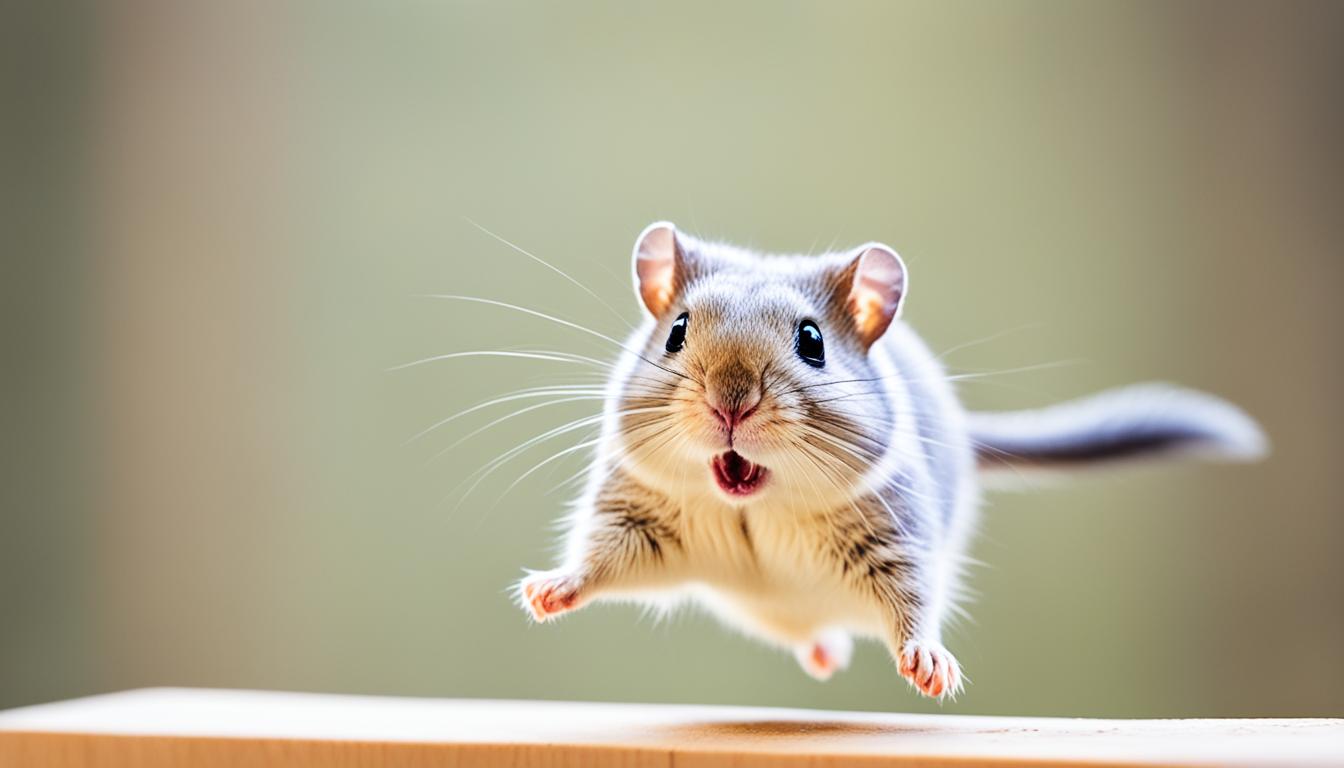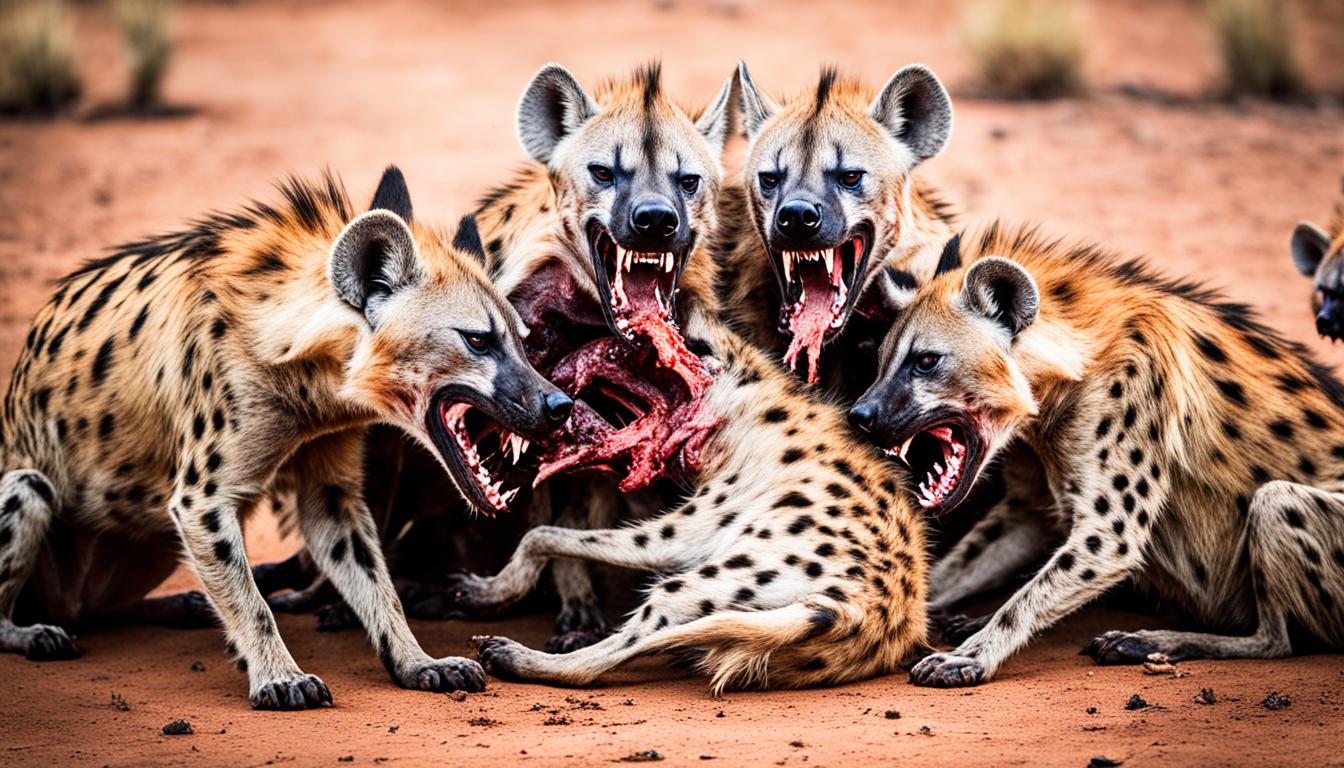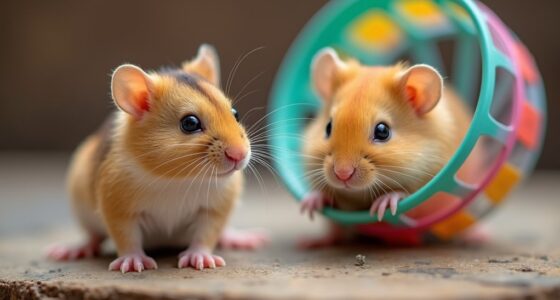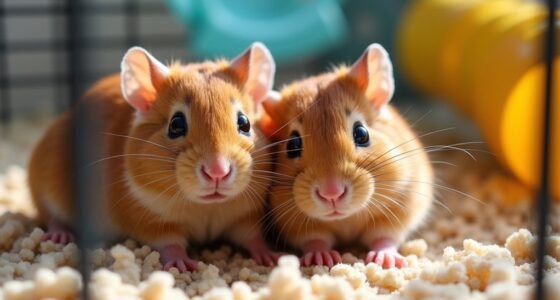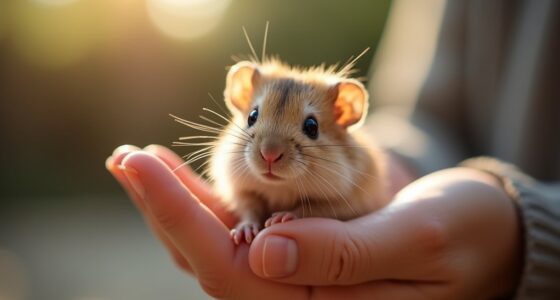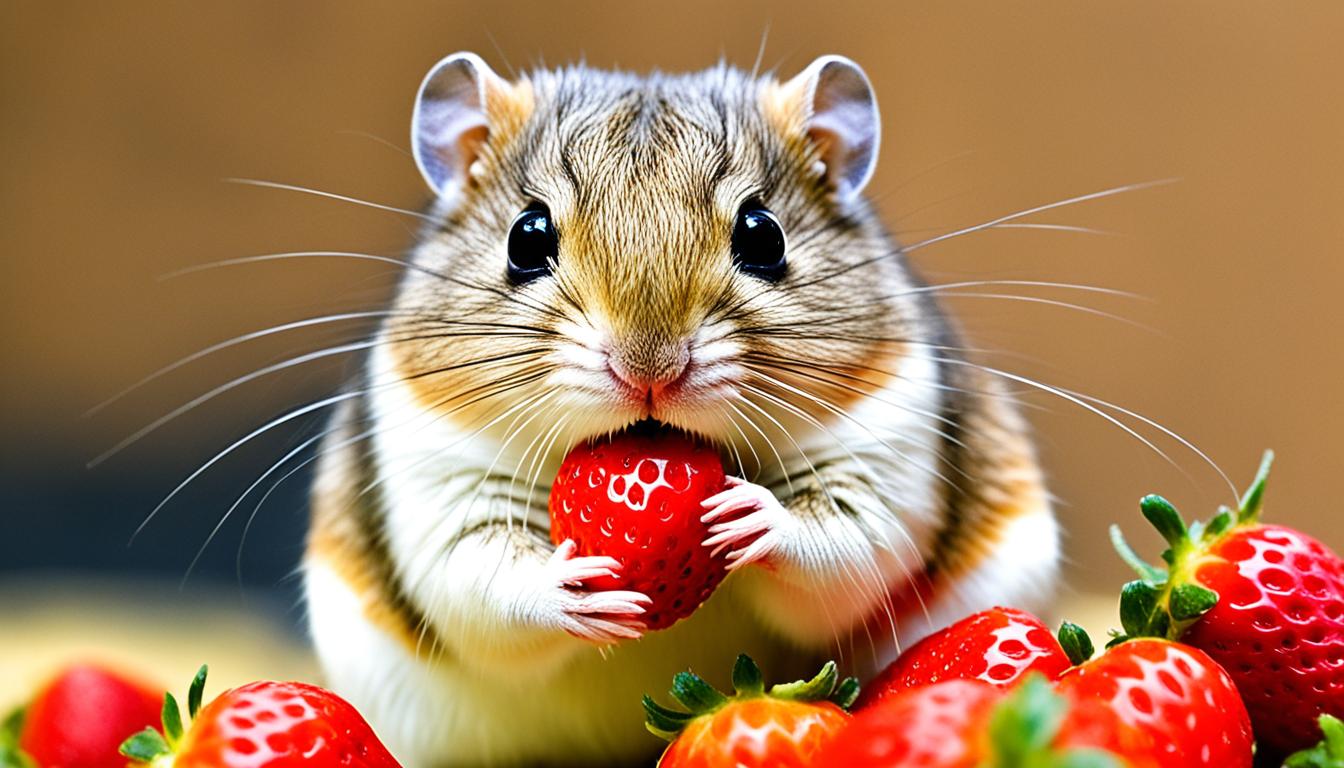Did you know that gerbils are skilled jumpers, capable of leaping up to a foot in the air? These small, lovable rodents have impressive physical abilities that make them captivating creatures to observe and have as pets. Whether you’re a rodent enthusiast or simply interested in these fascinating animals, we’re here to offer you a plethora of gerbil facts that will astonish and entertain you.
Key Takeaways:
- Gerbils are skilled jumpers and can leap up to a foot in the air.
- They are highly social animals that thrive in pairs or small colonies.
- Gerbils utilize a unique combination of vocalizations, body language, and scent marking to communicate with each other.
- These rodents have adapted to conserve water in their bodies, allowing them to survive in desert environments.
- Gerbils have continuously growing teeth and engage in gnawing behaviors to keep their dental health in check.
Gerbils are Social Animals
Gerbils are highly social creatures that thrive in the company of others. They enjoy living in pairs or small colonies and form strong bonds with their fellow gerbil companions. Keeping gerbils in pairs or small groups is essential for their social and emotional well-being.
Gerbils engage in cooperative and playful behavior with their cage mates, creating a lively and interactive environment. They enjoy grooming each other, which not only strengthens their bond but also helps them maintain good hygiene.
“Living with other gerbils allows them to express their natural instincts and engage in social activities that promote their overall well-being.”
Playing together is a favorite pastime for gerbils, as they chase each other, wrestle, and engage in friendly games. This playful interaction not only provides physical exercise but also stimulates their mental faculties and keeps them mentally stimulated.
In addition to grooming and playing, gerbils also cuddle with their companions, seeking comfort and warmth in each other’s presence. This cuddling behavior is a display of trust and affection between gerbil companions.
Benefits of Social Interaction for Gerbils
Social interaction plays a crucial role in gerbil’s lives and offers several benefits:
- Promotes emotional well-being and reduces stress
- Enhances physical exercise and agility
- Stimulates mental stimulation and cognitive abilities
- Provides opportunities for learning through observational behavior
- Offers companionship and reduces feelings of loneliness
Recognizing the social nature of gerbils, it is important to ensure they have suitable companionship to fulfill their social needs. Always introduce gerbils to their companions gradually and provide a spacious habitat to accommodate their social interactions.

Gerbils have a Unique Mode of Communication
Gerbils are not only adorable but also fascinating creatures when it comes to communication. They possess a rich repertoire of vocalizations, body language, and scent marking techniques to convey their thoughts, emotions, and intentions to their fellow gerbils. Let’s delve into the fascinating world of gerbil communication.
Vocalizations
Through various vocalizations, gerbils express a wide range of emotions and messages. They communicate using squeaks, chirps, and other distinctive sounds. For instance, a high-pitched squeak can indicate excitement or happiness, while a low growl may signify aggression or territorial disputes. By fine-tuning their vocalizations, gerbils establish social bonds and maintain harmony within their groups.
Body Language
Gerbils are masters of body language, using their postures, movements, and gestures to communicate non-verbally. They thump their hind legs on the ground or drum their feet to signal danger or to alert others about potential threats. When gerbils stand upright on their hind legs, it conveys curiosity and heightened vigilance. These body language cues allow gerbils to coordinate their activities and maintain a strong social structure.
Scent Marking
Scent marking plays a crucial role in gerbil communication. Gerbils possess scent glands, typically located on their bellies or near their genitals, which they use to mark their territories. By rubbing their bodies or dragging their tails across surfaces, they leave behind scent trails that indicate ownership and establish hierarchies within their groups. Scent marking also conveys important information about reproduction and mating availability.
“Gerbils use a combination of vocalizations, body language, and scent marking to communicate effectively with their fellow gerbils.”
Understanding the intricacies of gerbil communication allows us to appreciate the complexity and sophistication of their social lives. By observing their vocalizations, body language, and scent marking behaviors, we can gain valuable insights into their emotions, interaction patterns, and group dynamics.

Stay tuned for the following sections, where we will explore more captivating aspects of gerbil behavior and unravel the secrets of these fascinating furry creatures.
Gerbils have Exceptional Jumping Abilities
Gerbils are agile little creatures with exceptional jumping abilities. They can leap up to a foot in the air, using their powerful hind legs to propel themselves with precision.
This natural behavior allows gerbils to explore their surroundings and navigate their environment effectively. Jumping is not only a means of transportation for gerbils but also a way to escape from predators and reach higher vantage points to survey their territory.
Ample space and opportunities for jumping are crucial for gerbils to maintain their physical and mental well-being. It is important to provide them with a habitat that allows them to exercise their agility and fulfill their natural inclination for exploration.
When setting up their enclosure, consider incorporating platforms, ramps, and tunnels to create vertical and horizontal spaces for them to jump and play. This will stimulate their senses and promote their overall health.
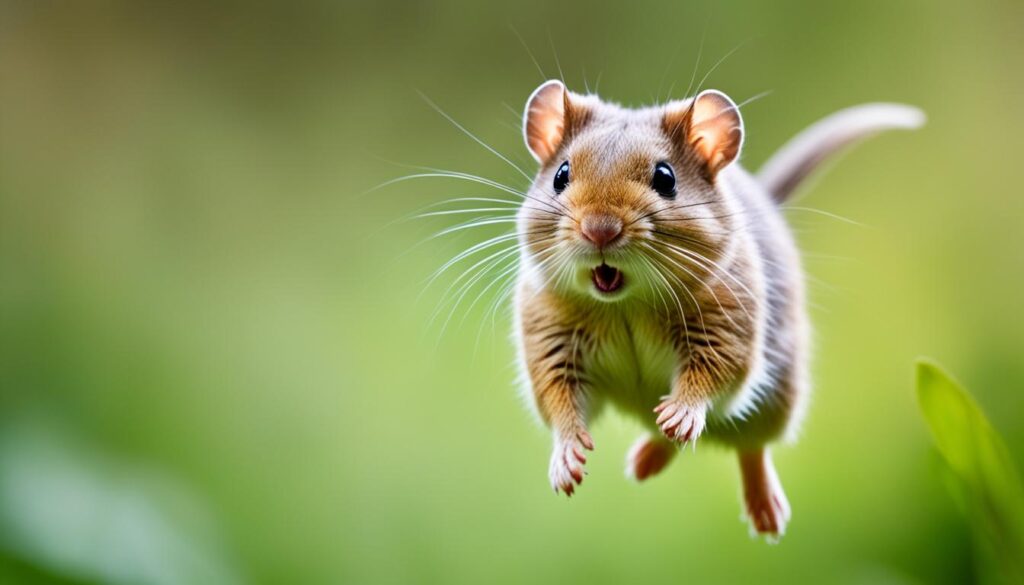
“Watching my gerbils jump and navigate through their habitat brings me so much joy. It’s fascinating to witness their agility and how effortlessly they can reach new heights.”
Gerbils have Adapted to Conserve Water
Gerbils are fascinating desert animals that have evolved remarkable adaptations to survive in arid conditions. One of their most impressive adaptations is their ability to conserve water in their bodies.
Native to desert environments, gerbils have developed the incredible skill of extracting moisture from their food. This unique adaptation allows them to go for long periods without drinking water, helping them thrive in their natural habitat.
To emphasize their water conservation abilities, we must understand that gerbils have specialized kidneys that enable them to reabsorb most of the water from their urine. This process allows them to retain as much water as possible and minimize water loss.
However, it is crucial to note that while gerbils can survive without drinking water for extended periods, it is still essential to provide them with fresh water at all times. Hydration is as important for gerbils as it is for any other living being.
“Water conservation is a vital survival strategy for gerbils living in arid habitats. By extracting moisture from their food, they can minimize water loss and maintain their physiological functions.”
By understanding gerbils’ water conservation abilities, we can create suitable environments that support their natural behaviors and ensure their well-being. Providing fresh water, in addition to a balanced diet and appropriate habitat, is a fundamental aspect of responsible gerbil care.
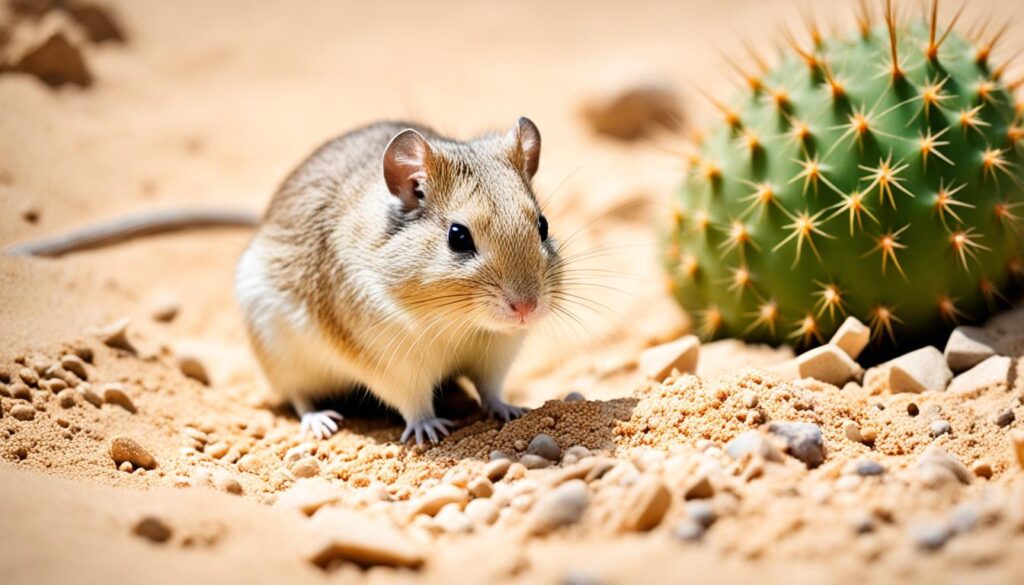
Next, we will explore another captivating behavior of gerbils – their natural instinct to hoard food. Join us in section 6 as we delve into the world of gerbil food hoarding and discover fascinating insights about their cheek pouches.
Gerbils Love to Hoard Food
Gerbils have a fascinating behavior of food hoarding, which stems from their natural instincts. These adorable rodents gather food in their specialized cheek pouches and transport it to their designated storage areas within their habitat. This unique behavior serves an important purpose in the wild and can also be observed in gerbils kept as pets.
When gerbils encounter an abundance of food, they instinctively collect as much as their expandable cheek pouches can hold. These remarkable cheek pouches allow gerbils to efficiently store and carry a significant amount of food, enabling them to easily transport it to their desired location. This behavior is particularly beneficial for gerbils as it helps them stockpile extra food for times when resources may be scarce or during their active periods.
Food hoarding is not only an essential survival strategy for gerbils but also a fascinating behavior to observe. It showcases their intelligence and resourcefulness in adapting to their environment. Additionally, food hoarding serves as a form of entertainment and mental stimulation for gerbils, allowing them to engage in natural foraging behaviors even in their captive settings.
Moreover, gerbil food hoarding is a key aspect of their territorial behavior. By storing food in various locations within their habitat, gerbils mark their territory and distinguish it from neighboring areas. This territorial marking helps prevent conflicts over resources with other gerbils, enabling them to coexist harmoniously in their shared space.
The Benefits of Gerbil Food Hoarding
Gerbil food hoarding offers several advantages for these adorable rodents:
- Resource Availability: By hoarding food, gerbils ensure a ready supply of food during times of scarcity or when they need a quick snack.
- Energy Conservation: Hoarding allows gerbils to secure and save energy by reducing the need for constant foraging.
- Survival: By storing food, gerbils can survive unexpected disruptions or shortages in their food supply, increasing their chances of survival.
- Behavioral Enrichment: Hoarding provides gerbils with mental stimulation and allows them to engage in natural foraging behaviors, which is important for their overall well-being.
Overall, gerbil food hoarding is an intriguing behavior that showcases their resourcefulness and adaptability. It also contributes to their physical and mental health by ensuring a consistent food supply and providing behavioral enrichment.
“Food hoarding is an essential behavior for gerbils, playing a crucial role in their survival and territorial marking.”
| Benefits of Gerbil Food Hoarding |
|---|
| Resource Availability |
| Energy Conservation |
| Survival |
| Behavioral Enrichment |
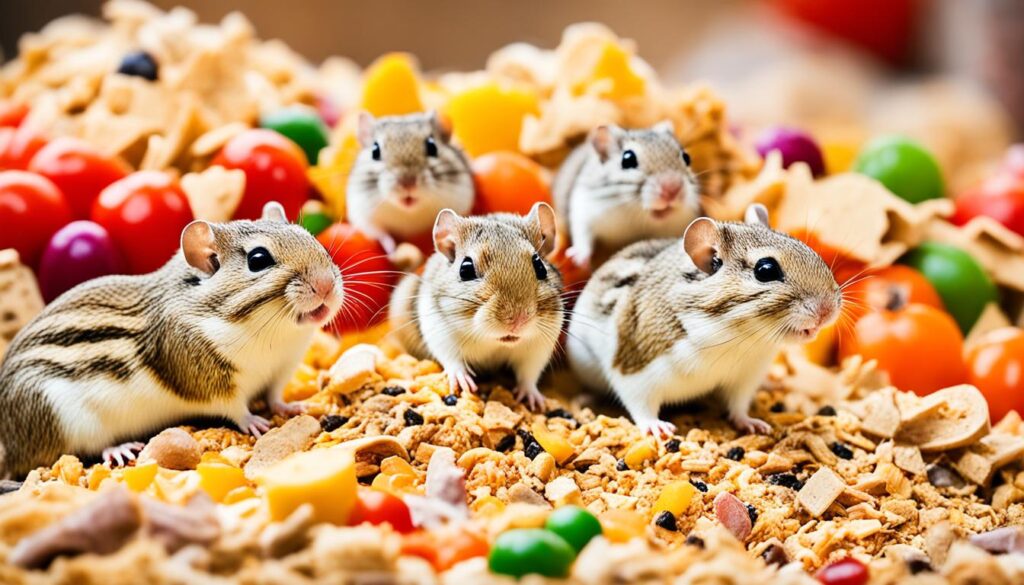
Gerbils have Continuously Growing Teeth
Gerbils have incisors that never stop growing. This unique dental feature sets them apart from other rodents. To prevent their teeth from overgrowing, gerbils engage in constant gnawing behavior. By gnawing on various objects such as wood, chew toys, and other materials, gerbils keep their teeth at a proper length. This behavior is essential for their dental health and overall well-being.
Gnawing serves two important purposes for gerbils. Firstly, it helps wear down their teeth, preventing them from becoming too long. Secondly, it provides mental stimulation and physical exercise for these active little rodents. The gnawing motion strengthens their jaw muscles, keeping them healthy and well-developed.
As responsible gerbil owners, it’s crucial to provide appropriate chew toys and objects for your furry friends to gnaw on. These items should be safe and durable, specifically designed for small rodents like gerbils. Avoid giving them objects made of plastic or other materials that can be ingested or cause harm.
Offering a variety of chew toys not only satisfies their natural gnawing instincts but also helps prevent boredom and destructive behavior. Wooden blocks, mineral blocks, and untreated branches are excellent choices. Ensure that the objects are free from any harmful coatings or chemicals.
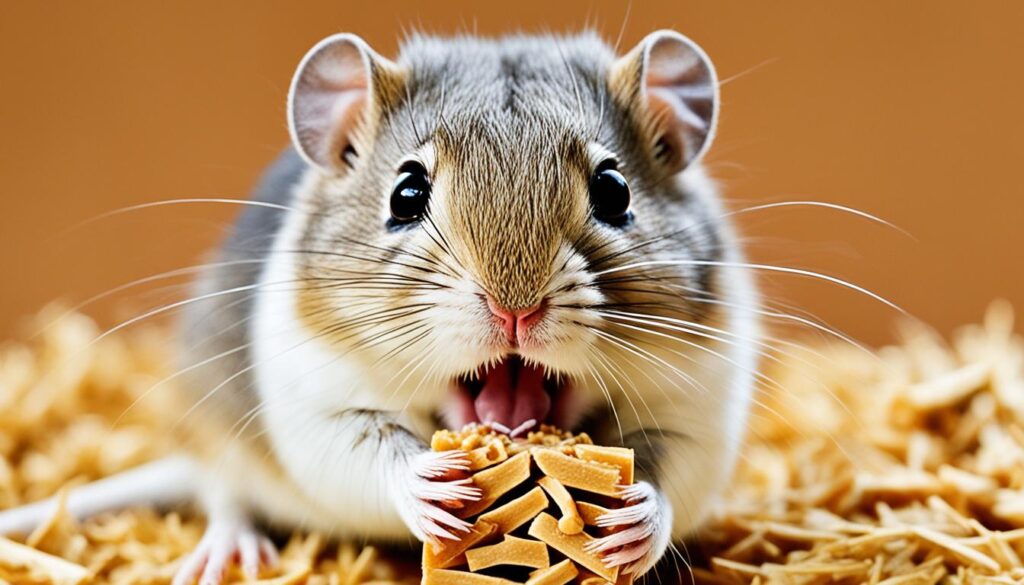
In conclusion, gerbils’ continuously growing teeth necessitate a regular opportunity for gnawing behavior. By providing suitable chew toys and objects, gerbil owners can promote dental health and keep their furry companions happy and entertained.
Gerbils are Expert Burrowers
Gerbils have a remarkable talent for burrowing, creating elaborate underground tunnels and chambers. This natural behavior showcases their adaptability and ingenuity. Using their strong front paws and sharp claws, gerbils dig deep, complex burrow systems that serve as their homes, providing protection from predators and a safe place to sleep, store food, and raise their young.
These underground tunnels offer gerbils a sense of security and privacy, allowing them to engage in natural behaviors and establish territories within their habitats. Burrowing also helps regulate their body temperature, as the tunnels provide insulation from extreme heat or cold.
Not only do gerbils create intricate tunnel systems, but they also exhibit exceptional navigational skills within this underground network. They memorize the layout of their tunnels and use landmarks and scent markers to find their way around.
“Gerbils’ burrowing behavior is an essential part of their natural instincts and contributes to their overall well-being.”
The gerbil burrowing behavior is not only fascinating but also serves important purposes for their survival and overall well-being. By observing gerbils’ burrowing habits, we gain insight into their natural instincts and behaviors, allowing us to provide them with suitable habitats and enriching activities to support their physical and mental health.
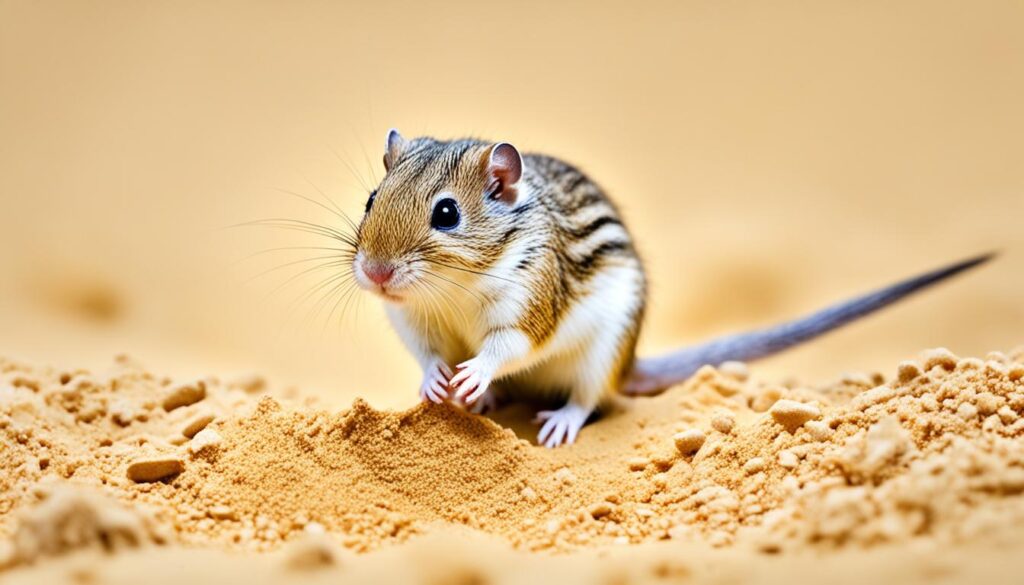
The Benefits of Gerbil Burrowing:
- Protection from predators
- Creation of safe sleeping and nesting areas
- Regulation of body temperature
- Opportunity for natural exploration and exercise
By understanding and appreciating the gerbil’s exceptional burrowing abilities, we can cultivate a deeper understanding of these fascinating rodents and provide them with a suitable environment to thrive.
| Benefits of Gerbil Burrowing | Description |
|---|---|
| Protection from predators | By burrowing underground, gerbils can escape from predators and find safety in their intricate tunnel systems. |
| Creation of safe sleeping and nesting areas | The tunnels provide gerbils with cozy, secure spaces for resting, sleeping, and raising their young. |
| Regulation of body temperature | The burrows offer insulation from extreme temperatures, allowing gerbils to maintain a comfortable body temperature. |
| Opportunity for natural exploration and exercise | Gerbils can engage in their natural behaviors, such as digging and tunneling, which provides mental stimulation and physical exercise. |
Gerbils have a Lifespan of 2-4 Years
Gerbils are delightful small pets that bring joy to many homes. However, it’s important to understand that they have a relatively short lifespan compared to some other small animals. On average, gerbils live for about 2-4 years.
But don’t worry! With proper care, you can help your gerbil live a happy and healthy life that may extend beyond their average lifespan. By providing them with the necessary care, you can increase their chances of enjoying companionship and fun for years to come.
Ensuring gerbil longevity involves a few key factors:
- Regular Veterinary Check-Ups: Accessing veterinary care is essential to monitor your gerbil’s health and detect any potential issues early on. Regular check-ups can help identify and address health concerns, ensuring your furry friend receives prompt treatment.
- Proper Diet: A balanced and nutritious diet plays a crucial role in the overall well-being and longevity of gerbils. Providing them with a diet rich in fresh vegetables, high-quality pellets, and occasional treats will help keep them healthy and happy.
- Enriched Environment: Gerbils are active animals that require mental stimulation and physical exercise. Create an enriched environment for your gerbil by providing plenty of toys, tunnels, and opportunities for play and exploration.
By following these guidelines and offering your gerbil a warm and loving home, you can help maximize their lifespan and create cherished memories together.
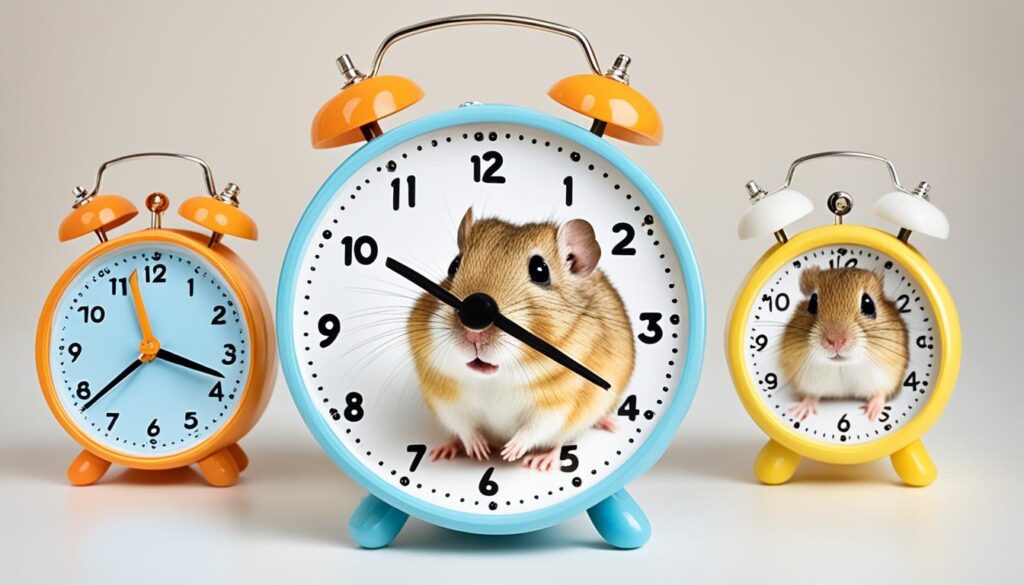
Expert Tip:
“Remember, every gerbil is unique, and their lifespan can vary. Some gerbils may live longer than others, while some may live shorter lives. By providing them with optimal care, you’re giving your gerbil the best chance at a long and fulfilling life by your side.”
Gerbils Are Skilled Cleaners
Gerbils are naturally clean animals and spend a significant amount of time grooming themselves and their fellow gerbils. They understand the importance of hygiene in maintaining a healthy and pleasant living environment within their group.
Grooming plays a vital role in gerbil health. These adorable rodents use their tongues to meticulously clean their fur, removing dirt, debris, and parasites. Regular grooming helps keep their coats in optimal condition, promoting a healthy appearance and preventing skin issues.
But grooming isn’t just limited to self-care. Gerbils also groom their cage mates as a sign of affection and social bonding. This act of mutual grooming not only strengthens their relationships but also helps to distribute natural oils, ensuring a consistent coat quality among group members.
To support their grooming behaviors, it’s essential to provide gerbils with appropriate grooming materials. Dust baths or brushes can be introduced into their habitat to facilitate their grooming routines. These tools help mimic the natural environment where gerbils would typically roll in dust to keep their fur clean and free from excess oils.
The attention to grooming and hygiene that gerbils demonstrate is truly remarkable. Their dedication to cleanliness contributes to their overall well-being, and it’s fascinating to observe their meticulous grooming rituals.
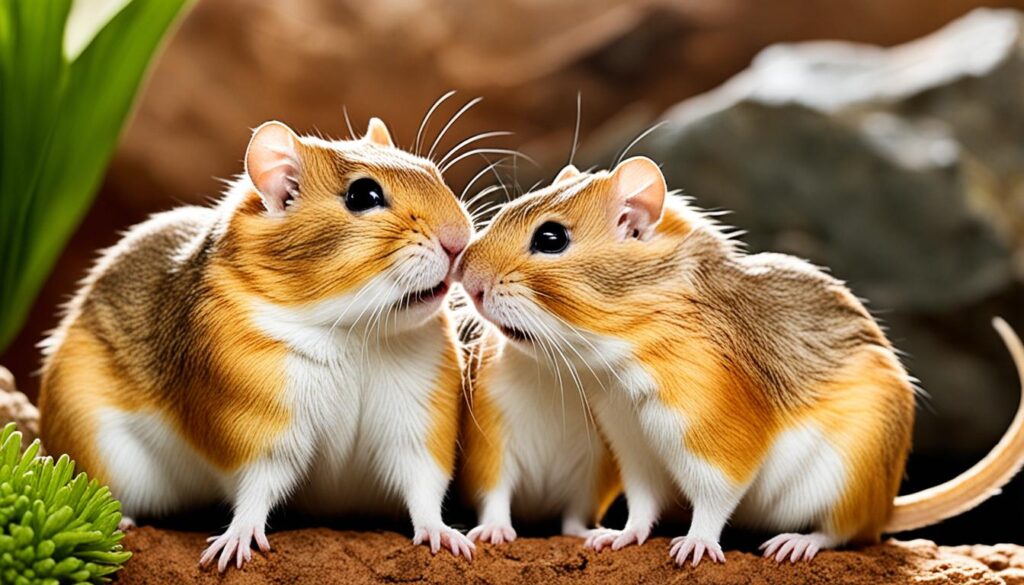
Gerbils Have a Wide Range of Coat Colors
Gerbils are not only known for their adorable and playful nature, but also for their stunning variety of coat colors. With hues ranging from agouti to black, white to spotted patterns, each gerbil boasts a unique and captivating appearance. Whether you prefer the elegance of a solid black coat or the charm of a multi-colored pattern, there is a gerbil to suit every taste.
The diverse coat colors of gerbils make them visually appealing pets, adding an extra touch of charm to their already lovable demeanor. Their coats can be smooth and sleek, or fluffy and soft, enhancing their overall visual appeal. Whether you are a fan of understated elegance or vibrant and striking colors, the array of gerbil coat variations provides an opportunity to find your perfect furry companion.
When choosing a gerbil based on coat color, it’s important to note that some colors may be more common than others. Agouti, a wild-type coat color featuring a mix of dark and light hairs, is a prevalent color in gerbils. However, breeders and pet stores often offer a wide range of coat colors, including black, white, and various shades in between. From vibrant oranges and creamy whites to rich browns and delicate grays, the possibilities are endless.
What’s more, certain coat patterns can make gerbils particularly eye-catching. Spotted gerbils, for example, boast adorable spots or speckles on their coats, further enhancing their visual appeal. Whether you are seeking a gerbil as a companion or as a show animal, the vast array of coat colors and patterns allows you to find a gerbil that suits your preferences and brings joy into your life.
